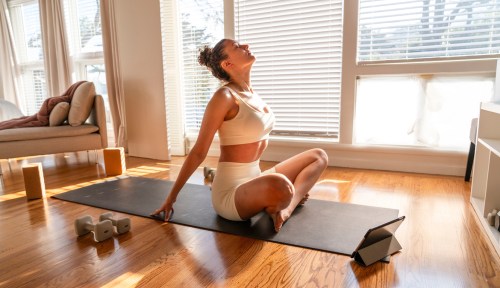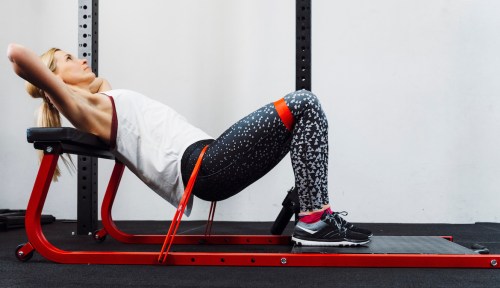The moment you decide to start a fitness routine, people are going to hit you with plenty of well-meant, unsolicited opinions. While it’s okay to seek help from the internet, trainers, and friends when you’re deciding how to sweat, it doesn’t hurt to have your radar up for some all-too-common workout myths that should have been retired long ago.
Experts in This Article
Alex Higa is a coach with Tempo, where she brings her years of experience as a dancer, pilates instructor, and personal trainer.
co-founder of Rumble Boxing
director of training and development at Solidcore
Ahead, trainers shut down five workout “rules” that just don’t hold water. Whether you think that you have to be sore for a workout to “count” or believe that 10 minutes isn’t worth the trouble, get ready for a perspective shift that’s sure to make you feel a little bit more free while doing the movement you love.
The 5 most-common workout myths trainers want to put to rest right now
1. Only modify exercises if you want to make them easier
“People often equate modifications with less intensity; however, choosing a modification may be the most-effective option to maintain proper form and full range of motion for the body,” says Taylor Bogenschuetz, director of training and development at [solidcore], a high-intensity, low-impact workout performed on a Pilates-style reformer.
Bogenschuetz says every workout should meet you where you are. For example, you may think that modifying a push-up, either by lowering your knees to the floor, or elevating your hands, is less “effective” or “impressive” than completing a full push-up. But the truth is that the modified version will also work your triceps, core, and shoulders. Then, when you gain the necessary strength, you’ll be able to perform a full push-up safely.
Here are a few push-up modifications to try in your next workout:
2. You have to use a fitness tracker to get good feedback
If you’re working out to seek the approval of your smart watch, Bogenschuetz says there’s another way. “From the moment you begin a workout to the second you end it, your fitness tracker measures your heart rate and displays an estimate of calories burned. These numbers alone are not a strong indication of the efficacy of your workout,” she says.
The reality is, the stats on your fitness tracker are good—but they don’t paint a full picture of the mental and physical benefits you reap from lifting weights, a great run, or an hour of yoga. “For example, the number of calories in a cardio-based class may read much higher than the number of calories tracked for a strength-based class,” says Bogenschuetz. “But following a resistance-based workout, the muscles will rebuild for about two days depending on the intensity. This rebuilding requires energy, or caloric burn from the body,”
The lesson here? Make sure your wearable isn’t the only way you’re measuring your progress. Consider keeping a fitness journal or clocking how you feel after a workout, as well.
3. You haven’t worked hard enough if you’re not sore
According to Bogenschuetz, many factors play into soreness—including how hydrated you are, how much sleep you got the night before, and how well you’re recovering. In other words: It’s far too variable to use as a metric for a successful workout. Luckily, Bogenschuetz and Tempo coach Alex Higa have a few brighter ideas for holding a yardstick up to your workouts.
“To measure progress, try tracking a measurable such as heart rate, weight used, or reps completed,” says Bogenschuetz. Meanwhile, Higa is a big fan of focusing on how your muscles feel throughout the workout instead of waiting to see how you feel afterward. “I always preach to listen to your body and make that mind-body connection when training. It can become a more efficient way of training, and it’s eye opening when you can truly understand your body and how it moves,” she says.
4. Always opt for long workouts over short
You don’t need to work out for 60 minutes straight to reap the benefits of exercise. “If you only have 10 minutes, do that. If you have 10 minutes, five times a day, that is 50 minutes spread throughout,” says Noah Neiman, co-founder of Rumble Boxing. “We have time for what we want to have time for, and sometimes you need to prioritize yourself.”
Short-and-sweet workouts are also a great way to manage your stress, improve your overall health, and build other healthy habits. So whether you have two minutes or a full hour today, make time to stretch, walk around the block, or move in another way that feels good to you.
Get moving with this 10-minute cardio core workout:
5. Consistency counts, so don’t take rest days
“‘No days off’ is another ‘motto’ that could be more harmful in the long run,” says Higa. “Your body needs rest in order to function properly and to its full potential. Exercise is stress on your body, and if you are constantly putting your body through stress, there will be a point where it could lead to overuse and injury.”
Instead of pushing yourself to exercise every day, listen to your body: If you feel tired, try active recovery like foam rolling, fascia flossing, or stretching. Or, opt to skip movement altogether in favor of a massage, swim, or trip to a steam room.
Kick off your recovery with this full-body stretching routine:
Sign Up for Our Daily Newsletter
Get all the latest in wellness, trends, food, fitness, beauty, and more delivered right to your inbox.
Got it, you've been added to our email list.











